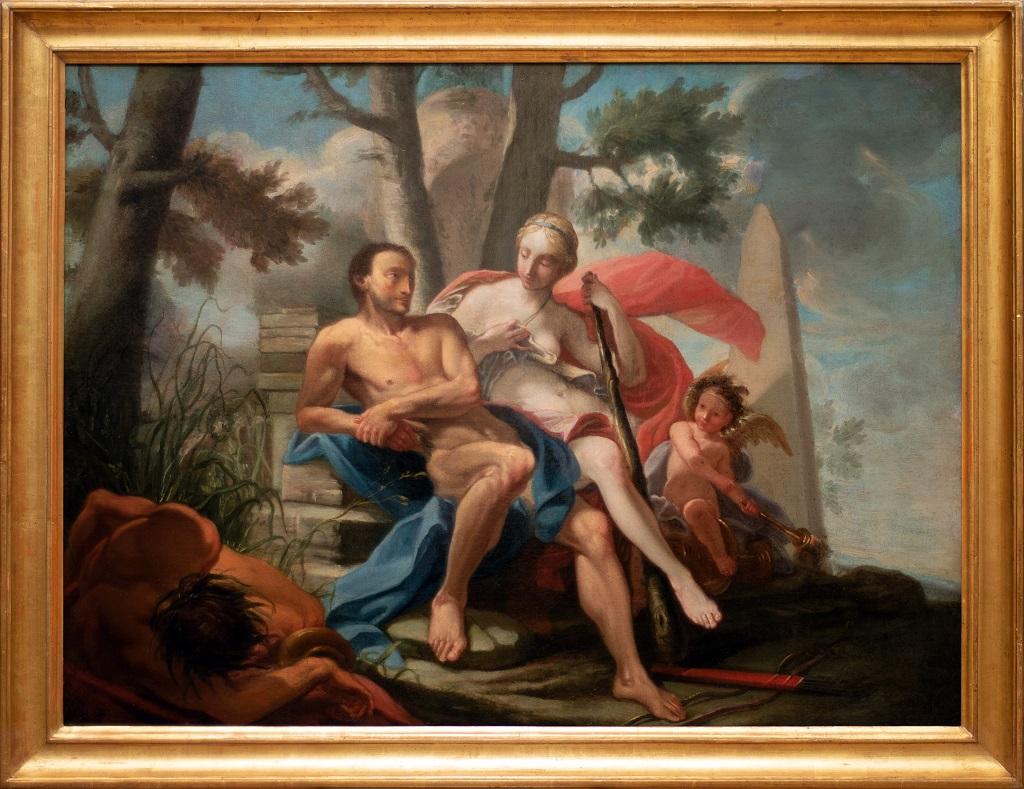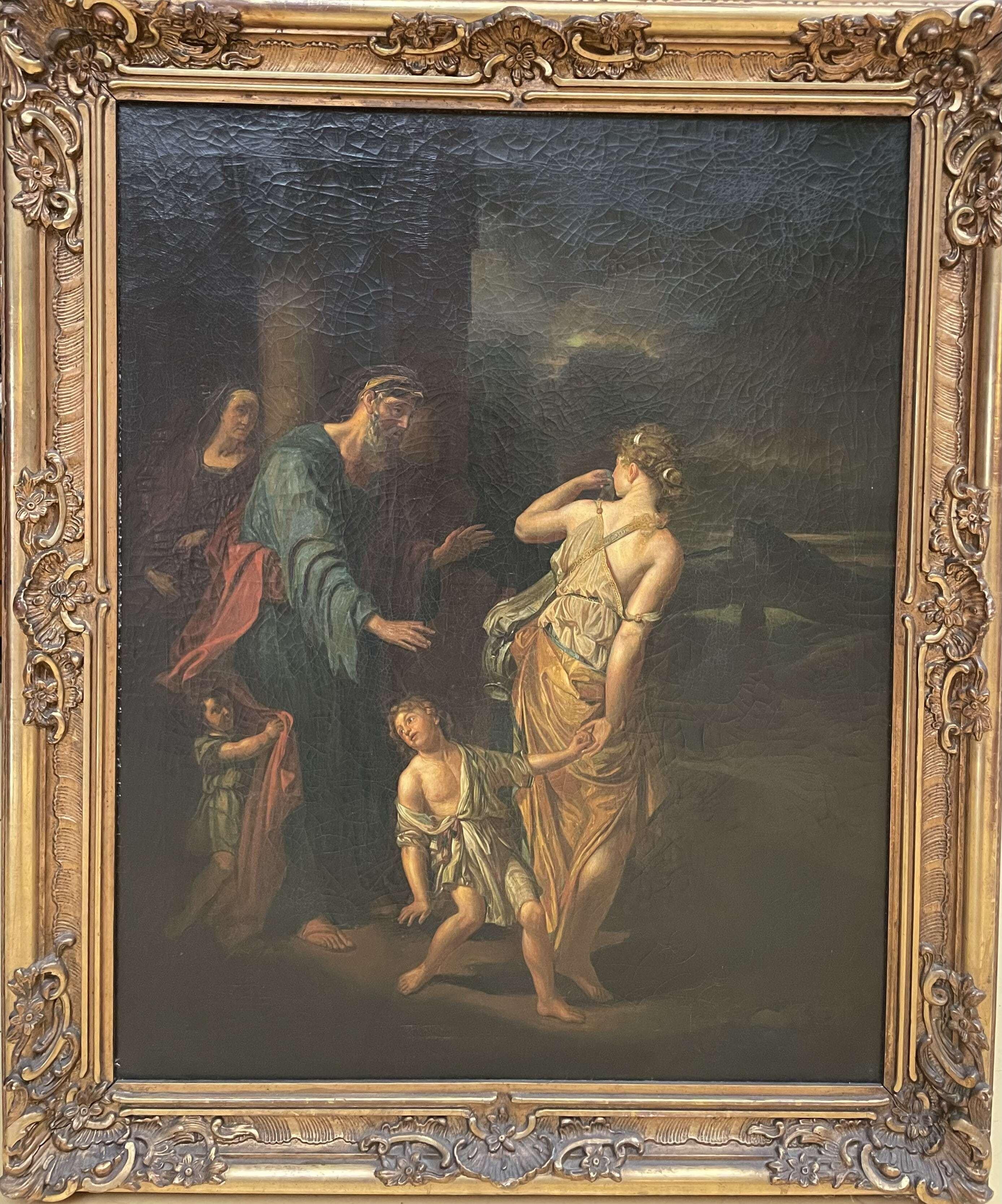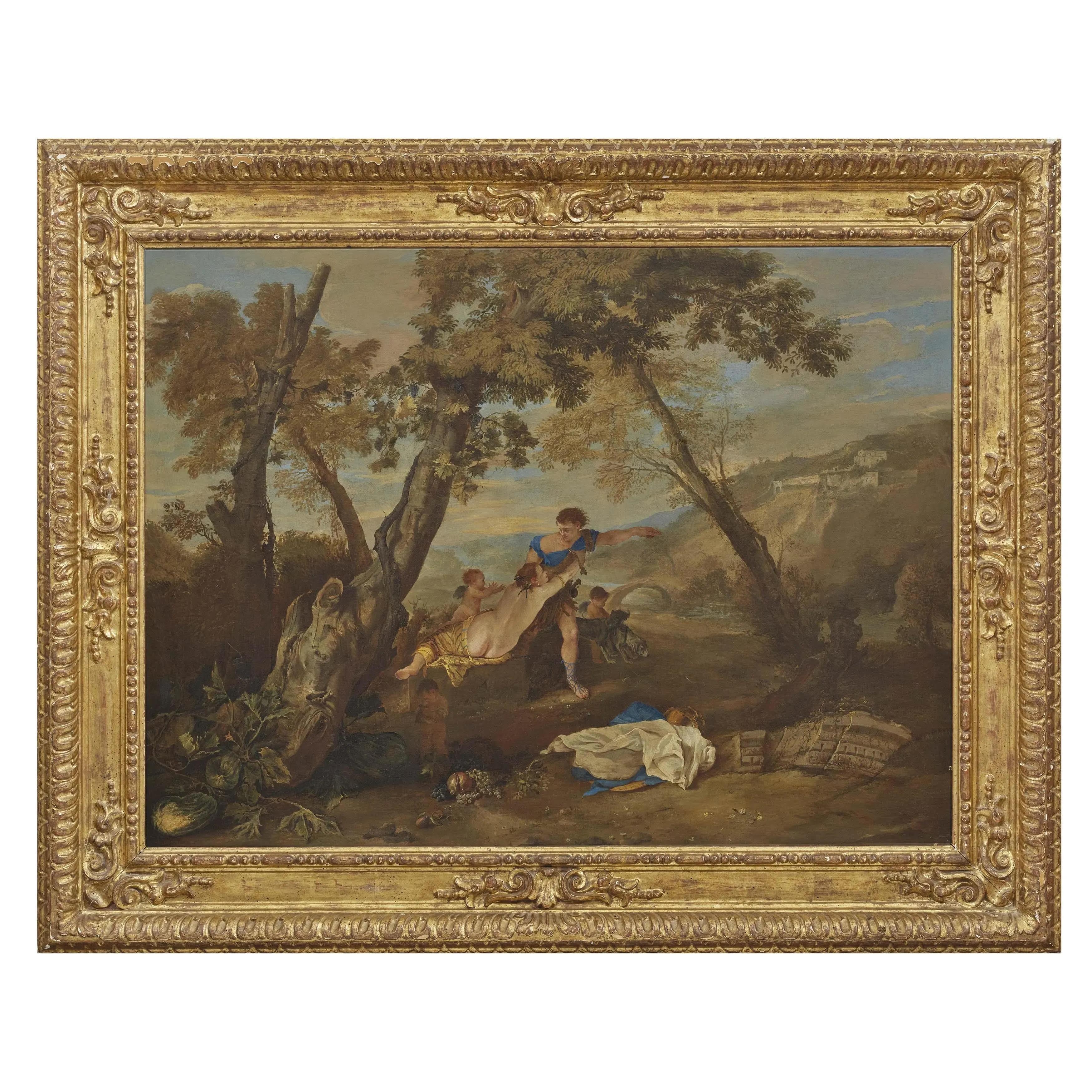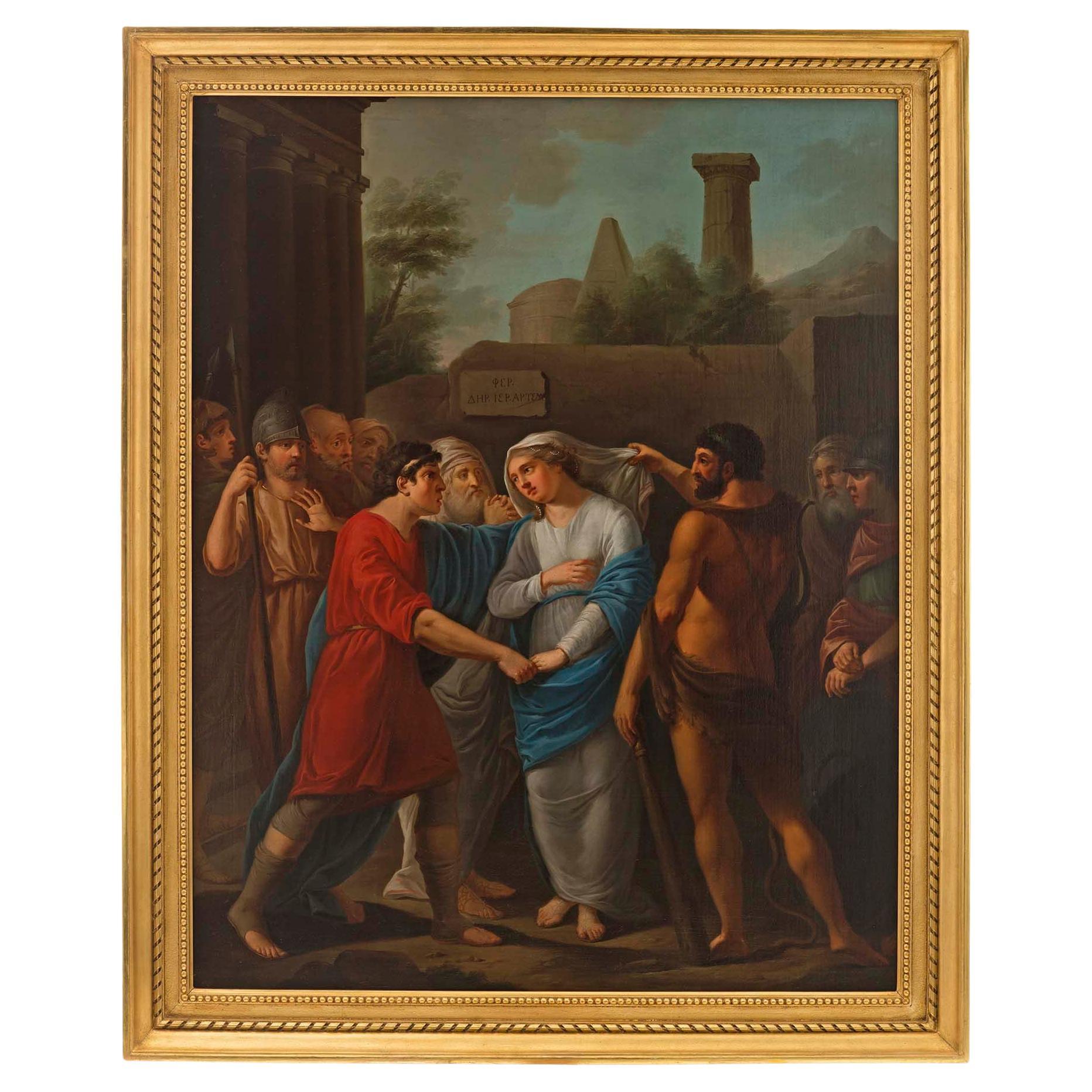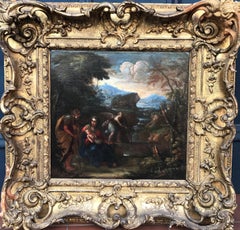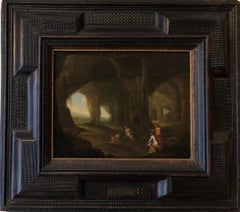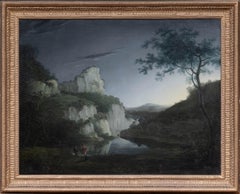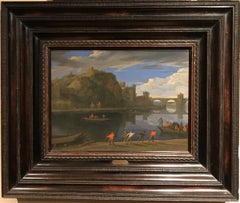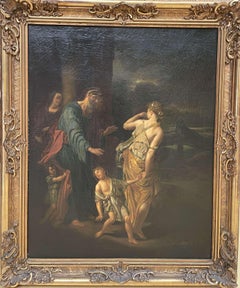Items Similar to 18th Century Neoclassical Oil Painting of the Trojan War: Briseis & Achilles
Want more images or videos?
Request additional images or videos from the seller
1 of 7
James Thornhill18th Century Neoclassical Oil Painting of the Trojan War: Briseis & Achillescirca 1710
circa 1710
$24,517.99
£18,000
€20,994.51
CA$34,170.37
A$37,476.58
CHF 19,599.43
MX$452,819.82
NOK 245,917.12
SEK 231,806.65
DKK 156,692.74
About the Item
James Thornhill (1674-1735)
Oil on canvas
12 x 14 inches;
16 ½ x 18 ½ in. Inc. frame
The subject matter and inclusion of herms on both sides shows the influence of Louis Laguerre (1663-1721) and Louis Cheron (1655-1725), two French history painters who were both employed in England to make large mural and ceiling decorations around the end of the 17th Century. The English painter James Thornhill became well known for reusing their devices and mythological themes a few years later. Thornhill received two of the most prestigious commissions in London: the painted decorations of Greenwhich Hospital and the dome of St Paul's Cathedral.
Besides these enormous ceilings, lots of sketches by Thornhill are held in public collections, such as the one in the Courtauld Institute that shows the same handling of figures and smooth brushwork as the painting on offer. Furthermore, episodes from the Trojan War were very fashionable at the time. The bearded man dressed in white is a priest and is leading a woman, Briseis, who has been taken prisoner and given as a war prize to the renowned warrior, Achilles. When the Greeks decided to release Briseis and Chrysies (the other woman held captive) to calm the Gods and allow their victory over the Trojans, all did not go to plan and Agamemnon claimed Briseis to replace Chryseis as his new mistress. This enraged Achilles who decided to stop fighting in protest. Such a loss amongst the Achaeans soldiers seriously threatened their position against the Trojans so Agamemnon recinded and gave Briseis back to Achilles. The moment depicted in this painting shows the very moment when Briseis meets Achilles again.
A drawing preserved in Melbourne, National Gallery of Victoria under the same name of James Thornhill confirms this attribution with a composition study where Briseis is surrounded by the Greeks in the centre and Achilles rushing towards her.
It is likely that the painting on offer was originally intended for Hanbury Hall in Worcestershire which was decorated by Thornhill around 1710 with the 'Life of Achilles'. In fact one of the scenes depicted at Hanbury is the immediate predecessor in the story - 'Briseis taken by Agamemnon to Achilles'.
- Creator:James Thornhill (1674 - 1735)
- Creation Year:circa 1710
- Dimensions:Height: 16.5 in (41.91 cm)Width: 18.5 in (46.99 cm)
- Medium:
- Movement & Style:
- Period:
- Condition:
- Gallery Location:London, GB
- Reference Number:1stDibs: LU67338421632
About the Seller
5.0
Vetted Professional Seller
Every seller passes strict standards for authenticity and reliability
Established in 1990
1stDibs seller since 2017
42 sales on 1stDibs
Typical response time: Several days
- ShippingRetrieving quote...Shipping from: London, United Kingdom
- Return Policy
Authenticity Guarantee
In the unlikely event there’s an issue with an item’s authenticity, contact us within 1 year for a full refund. DetailsMoney-Back Guarantee
If your item is not as described, is damaged in transit, or does not arrive, contact us within 7 days for a full refund. Details24-Hour Cancellation
You have a 24-hour grace period in which to reconsider your purchase, with no questions asked.Vetted Professional Sellers
Our world-class sellers must adhere to strict standards for service and quality, maintaining the integrity of our listings.Price-Match Guarantee
If you find that a seller listed the same item for a lower price elsewhere, we’ll match it.Trusted Global Delivery
Our best-in-class carrier network provides specialized shipping options worldwide, including custom delivery.More From This Seller
View All17th Century Old Master Religious Oil painting - Rest on the Flight into Egypt
By Pier Francesco Mola
Located in London, GB
Attributed to Pier Francesco MOLA, called Il TICINESE (1612-1666)
Rest on the Flight into Egypt
oil on canvas
25.5 x 27 inches including ...
Category
Mid-17th Century Baroque Figurative Paintings
Materials
Oil
17th Century Classical Oil Painting - Diana With Her Attendants in a Grotto
By Abraham van Cuylenborch
Located in London, GB
Abraham van CUYLENBROCH (1620-1658)
Diana With Her Attendants in a Grotto
1651
signed
oil on panel
12.2 in x 15.7 inches, inc. frame;
31 x 40 cm
Provenance:
Sale of Sotheby's Lo...
Category
17th Century Old Masters Figurative Paintings
Materials
Oil
18th Century Lanscape Oil Painting of Matlock High-Torr
By Thomas Smith (b.1720)
Located in London, GB
Thomas Smith of Derby
Matlock High-Torr Landscape
Oil on canvas
27 x 34.5 inches unframed
34 x 41.5 inches including frame
Thomas Smith of Derby (died 12 September 1767) was an Engl...
Category
18th Century Old Masters Landscape Paintings
Materials
Oil
Oil Painting of Landscape with 'The Papal Palace at Avignon'
By Pieter Bout
Located in London, GB
Provenance:
Sotheby’s December 5th 2006, Lot 388
Bout was a Flemish painter, draughtsman and etcher. He is known mainly for his landscapes, city, coast and country views and archite...
Category
Early 18th Century Old Masters Landscape Paintings
Materials
Oil
19th Century Landscape Oil Painting - Deer by the Banks of a Lake
By Jacob Thompson
Located in London, GB
Jacob THOMPSON (1806 – 1879)
Deer by the Banks of a Lake
1842
oil on canvas
18.9 x 27.6 inches;
22.5 x 31 inches Inc. frame
Jacob Thompson (1806–1879) was an English landscape-pa...
Category
1840s Old Masters Figurative Paintings
Materials
Oil
19th Century Oil painting of horses - Mares and Foals in a Landscape
By Daniel Clowes
Located in London, GB
Daniel CLOWES (1774-1829) after George Stubbs
Mares and Foals in a Landscape
oil on canvas
29 x 33 inches, inc.frame
Daniel Clowes lived and worked in Chester all his life and ...
Category
19th Century Old Masters Animal Paintings
Materials
Oil
You May Also Like
Hercules and Omphale - Oil Painting on Canvas - 18th Century
Located in Roma, IT
Hercules and Omphale is an original painting realized in France between the end of the 18th and the beginning of the 19th Century.
Original oil painting on canvas. Dimensions: 73 x...
Category
Late 18th Century Modern Figurative Paintings
Materials
Canvas, Oil
Diana Boullogne Mythological Paint Oil on canvas old master 17/18th Century
Located in Riva del Garda, IT
Bon Boullogne (Paris, 1649 - Paris, 1717) workshop of
Episodes from the myth of Diana
oil painting on canvas
Dimensions: 84 x 114 cm.
with antique frame 100 x 132 cm.
The beautiful painting proposed shows a series of episodes taken from the myth of the divinity Diana, the Roman divinity of hunting, forests and wild animals, masterfully captured in this valuable painting, which shows a luxuriant wood, a favorite place of the divinity, as a theater of his adventures.
The composition opens, on the left, with a sort of presentation of the divinity, portrayed as an attractive young girl, surrounded by her faithful Nymphs, one of whom holds her quiver with arrows, and by one of her beloved dogs. hunting her.
The 'story' continues in the central part where we can see the divinity during a wild boar hunt...
Category
Late 17th Century Old Masters Paintings
Materials
Oil
$8,477 Sale Price
20% Off
The Expulsion of Hagar and Ishmael
Located in Edinburgh, GB
Copy of artwork by Adriaen van der Werff "The Expulsion of Hagar and Ishmael"
Artist: Unidentified (18th Century)
Date: Circa 1760–1770
Medium: Oil on canvas
Dimensions:
Framed: 124...
Category
18th Century Rococo Figurative Paintings
Materials
Canvas, Oil
Hagar Angel Sacrifice Isaac 18th Century Neapolitan School Old master Paint Oil
Located in Riva del Garda, IT
18th-century Neapolitan master
Pair of paintings ‘Hagar and the Angel’ and ’The Sacrifice of Isaac’
Pair of oils on oval canvas
75 x 60 cm. - In frame 84 x 69 cm.
The proposed pair...
Category
18th Century Old Masters Paintings
Materials
Oil
$8,424 Sale Price
20% Off
17th Century by Andrea De Lione Venus and Adonis Oil on canvas
Located in Milano, Lombardia
Andrea De Lione (Naples, Italy, 1610-1685)
Title: Venus and Adonis
Medium: Oil on canvas
Dimensions: without frame 78 x 102 – with frame 103 x 129 x 6.5 cm
Signed on the ruined arch...
Category
17th Century Old Masters Figurative Paintings
Materials
Canvas, Oil
$100,631 Sale Price
20% Off
German 18th Century Neoclassical Themed Oil on Canvas
Located in West Palm Beach, FL
A superb quality German 18th century Neo-classical themed oil on canvas by Johann Dominicus Fiorillo. The painting depicts a courtship in the town square with townspeople looking on. The maiden is draped in modest classical dress and the young man in a vibrant red garment, holds her hand. Wonderful execution and detail throughout. Johann Dominicus Fiorillo (Hamburg 1748 - 1821) was a German painter and historian of art. Fiorillo, a son of Italian...
Category
Antique 18th Century German Neoclassical Paintings
Materials
Canvas, Giltwood
More Ways To Browse
Neoclassicism Painting
18th Century Oil Painting Woman
Neoclassical Oil Painting
Trojan War
Louis Cheron
Emil Kazaz
Ernest Fredericks
Ethel Walker
Eva Makk
Fashion Illustrations 1920s
Ferdinand Fagerlin
Ford Gt40
Four Horsemen Of The Apocalypse
Francisco Ribera Gomez Painting
Frank Tolles Chamberlin
Frederick Childs
French Paintings Of Workers
Gay Men Art
